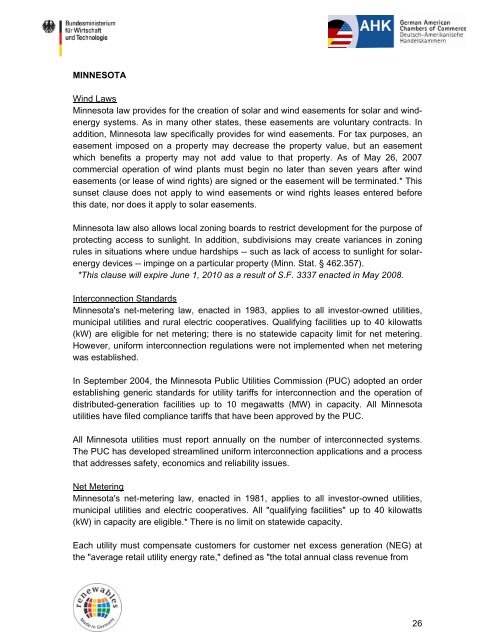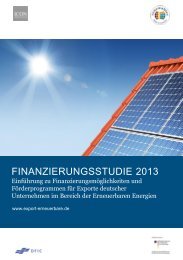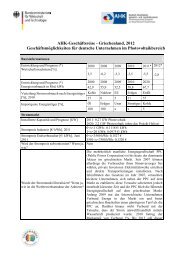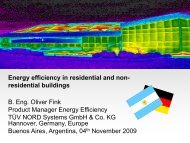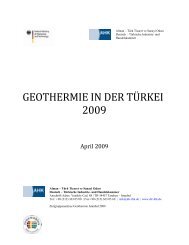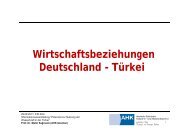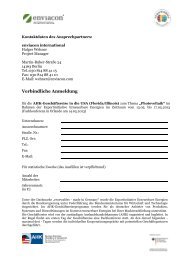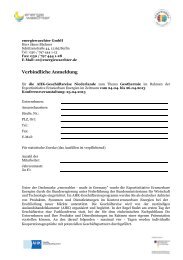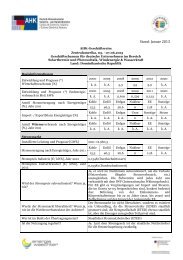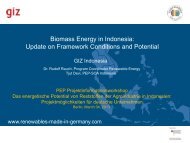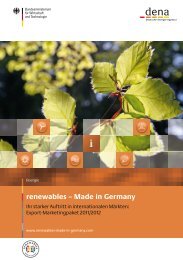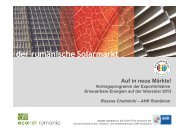PDF: 1,1 MB - Exportinitiative Erneuerbare Energien
PDF: 1,1 MB - Exportinitiative Erneuerbare Energien
PDF: 1,1 MB - Exportinitiative Erneuerbare Energien
- No tags were found...
Create successful ePaper yourself
Turn your PDF publications into a flip-book with our unique Google optimized e-Paper software.
MINNESOTA<br />
Wind Laws<br />
Minnesota law provides for the creation of solar and wind easements for solar and windenergy<br />
systems. As in many other states, these easements are voluntary contracts. In<br />
addition, Minnesota law specifically provides for wind easements. For tax purposes, an<br />
easement imposed on a property may decrease the property value, but an easement<br />
which benefits a property may not add value to that property. As of May 26, 2007<br />
commercial operation of wind plants must begin no later than seven years after wind<br />
easements (or lease of wind rights) are signed or the easement will be terminated.* This<br />
sunset clause does not apply to wind easements or wind rights leases entered before<br />
this date, nor does it apply to solar easements.<br />
Minnesota law also allows local zoning boards to restrict development for the purpose of<br />
protecting access to sunlight. In addition, subdivisions may create variances in zoning<br />
rules in situations where undue hardships -- such as lack of access to sunlight for solarenergy<br />
devices -- impinge on a particular property (Minn. Stat. § 462.357).<br />
*This clause will expire June 1, 2010 as a result of S.F. 3337 enacted in May 2008.<br />
Interconnection Standards<br />
Minnesota's net-metering law, enacted in 1983, applies to all investor-owned utilities,<br />
municipal utilities and rural electric cooperatives. Qualifying facilities up to 40 kilowatts<br />
(kW) are eligible for net metering; there is no statewide capacity limit for net metering.<br />
However, uniform interconnection regulations were not implemented when net metering<br />
was established.<br />
In September 2004, the Minnesota Public Utilities Commission (PUC) adopted an order<br />
establishing generic standards for utility tariffs for interconnection and the operation of<br />
distributed-generation facilities up to 10 megawatts (MW) in capacity. All Minnesota<br />
utilities have filed compliance tariffs that have been approved by the PUC.<br />
All Minnesota utilities must report annually on the number of interconnected systems.<br />
The PUC has developed streamlined uniform interconnection applications and a process<br />
that addresses safety, economics and reliability issues.<br />
Net Metering<br />
Minnesota's net-metering law, enacted in 1981, applies to all investor-owned utilities,<br />
municipal utilities and electric cooperatives. All "qualifying facilities" up to 40 kilowatts<br />
(kW) in capacity are eligible.* There is no limit on statewide capacity.<br />
Each utility must compensate customers for customer net excess generation (NEG) at<br />
the "average retail utility energy rate," defined as "the total annual class revenue from<br />
26


